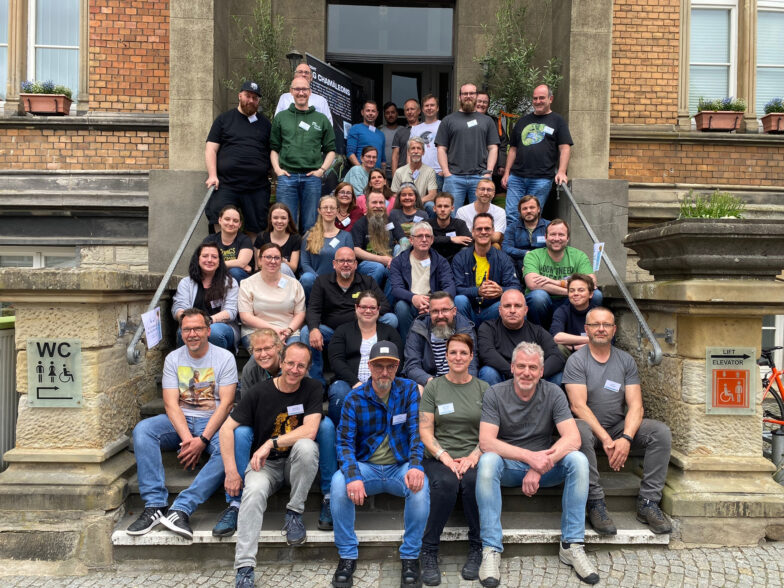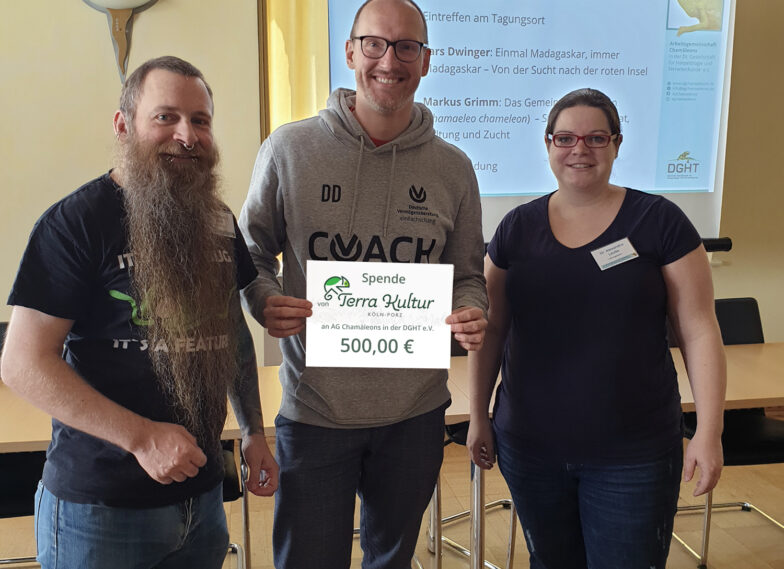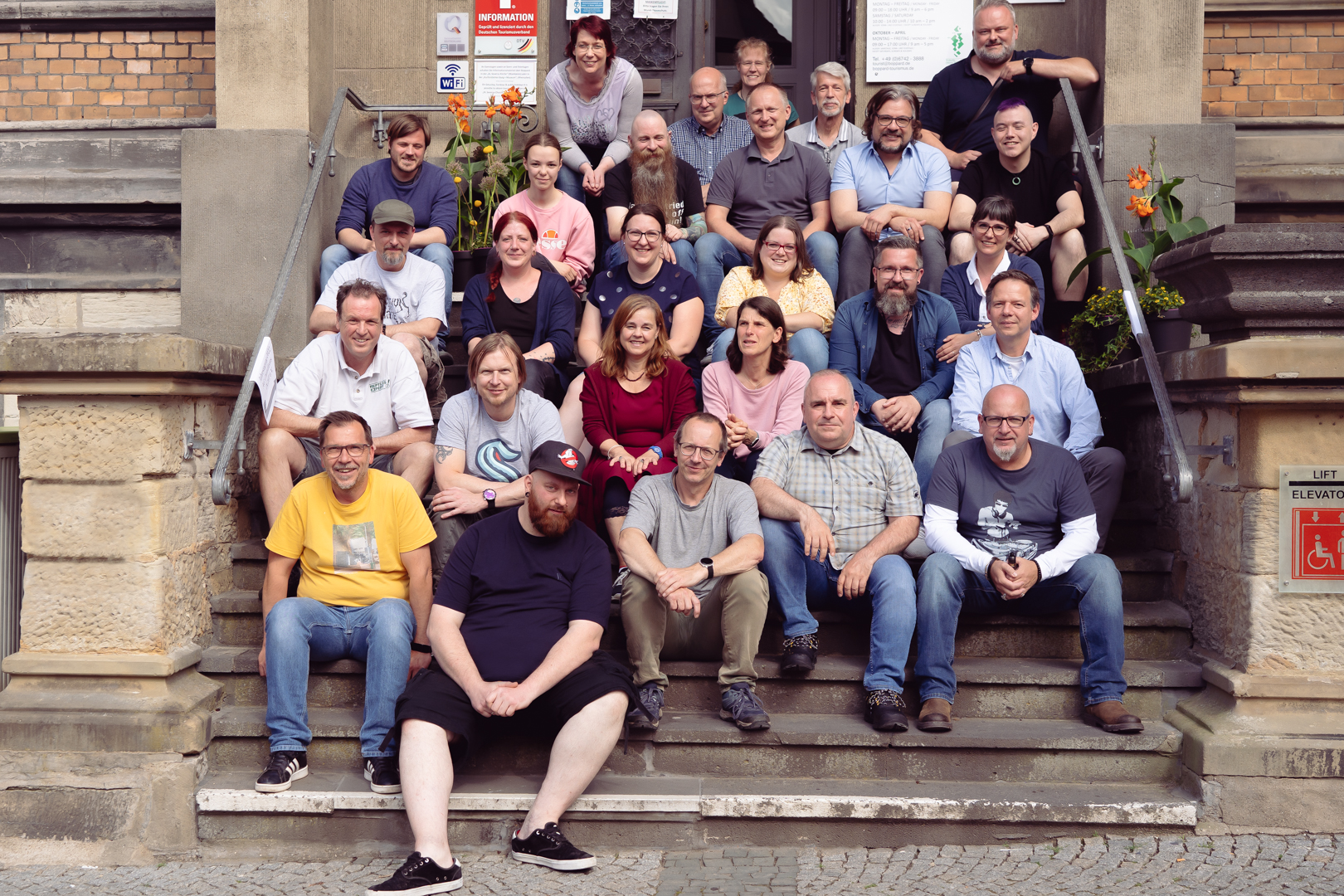From 05 to 07 May 2023, the annual meeting of the AG Chamäleons once again took place in Boppard am Rhein. Traditionally, the chameleon friends who had already arrived on Friday met at the Italian restaurant in the Rheinallee for a cosy dinner. After the location had changed owners and names several times in the past years, it is now called “Castello da Toni” again, as it was many years ago. An exchange of experiences and many exciting conversations heralded the conference.
Saturday morning started with a classic keeping and breeding session in front of almost 50 chameleon lovers who turned up. Jean-Dominique Dufraine gave a talk on two species that he has been keeping and breeding successfully for several years. Rieppeleon brevicaudatus, a terrestrial chameleon that seems to have been somewhat forgotten in herpetoculture in recent years, but which is a lot of fun to keep, will hopefully get a new chance to reappear in German terrariums in the future. The Seychelle’s Chameleon Archaius tigris is also small, but a species with interesting behaviour that can be kept in groups. Thorsten Negro then reported on his recent trip to Madagascar, where he went in search of the various Parson’s Chameleons of the red island. A special target was the “green giant“, the colour variant of the Parson’s Chameleon in the rainforest of Masoala, which had hardly been documented until then.
After the lunch break, we continued with legal aspects of terraristics, interestingly presented by Oliver Witte. Whether a tenant can prohibit the keeping of chameleons, whether a certificate of competence makes sense for everyone (yes!) and what rights and obligations you have when selling animals were just some of the topics discussed. In the photo competition, a beautiful photo of a Brookesia vadoni from Marojejy in Madagascar by Markus Bartels was chosen as the winner. He received a 50 € voucher from Chimaira as well as one of the beautiful conference collector’s mugs designed by Caro Vierbücher, which change chameleon species every year – depending on the winning motif of the previous year’s photo competition. Second place went to Markus Grimm with a photo of a Chamaeleo chamaeleon reticrista from the island of Samos in Greece. He received a 30 € voucher from QB Insects. Third place went to Monique Bartsch with a photo of a Calumma globifer she bred herself. She also received a voucher from QB Insects.
The eagerly awaited lecture by Dr. Sarina Wunderlich on the subject of UV-B LEDs. then went directly into practical herpetoculture. The conclusion after many measurements and considerations: Currently, the physicist advises against the use of UV-B LEDs over chameleon terrariums. However, the technical possibilities to reduce the previous deficits of LEDs are already available – just not affordable for the normal consumer so far. It is therefore realistic that UV-B LEDs will become usable in a few years. So we are eagerly awaiting an update in the not-too-distant future. The lecture part was concluded by Rayane Vuillemin, who presented the Association Caméléon Center Consérvation founded in Switzerland last year. Various projects are planned to draw greater public attention to the protection of chameleons. Among others, a project on the occurrence of chameleons in the Vohimana Special Reserve in Madagascar is currently being supported. Several chameleon species are also to be propagated across Europe as part of an ex-situ breeding programme to establish a stable population outside their home countries. An exciting project that we are sure to hear more about!
The general member meeting at the end of the day was pleasantly short. Treasurer Tim Vierbücher gave an overview of the current financial situation. WG spokesperson Dr Alexandra Laube presented the activities of the board in the past year. In addition to the complete overhaul of the website and increased activity in social media, a monthly newsletter was launched and a AG-owned cloud and a data management system were set up, especially for publications. The increased visibility generated a lot of approval among the AG members. The goals for the coming year are the revival of the breeding statistics and the 50th-anniversary issue of CHAMAELEO. In addition, there will be a survey on whether the conference should continue to take place in Boppard or whether it should change location again after 21 years. We are already looking forward to the result! The various ideas and presentations were then eagerly discussed at the joint dinner.
On Sunday, it started right on time with a travel report by Lars Dwinger, who actually comes from the aquatics scene and came to the chameleons via his first trip to Madagascar. He showed many great photos from the rainforests of Ranomafana and Andasibe in the highlands as well as Akanin’ny Nofy on the east coast of Madagascar and gave tips for travelling around the Indian Ocean. The conference ended as it began, with a husbandry report – this time by Markus Grimm. He told about the habitat of Chamaeleo chamaeleon reticrista in the wild and showed video and picture material of storm-beaten chameleons as well as mating. Afterwards, the expert examiner for Switzerland presented his own husbandry conditions for the species in the terrarium and gave a lot of information on how the successful incubation and breeding of the European Chameleon can succeed.
Finally, there were some great donations to the AG: Jean-Dominique Dufraine donated 500 €, Jutta Dwinger donated the proceeds of the bags she sold of 320 € and Caro Vierbücher rounded up the already impressive sum by another 100 € for the AG Chamäleons. Many thanks to all three donors! A big thank you also goes to all the speakers for their interesting and varied contributions and to the helpers in the background who made the conference a success. And finally, we would like to thank the DGHT Policy Advisory Board, Peter Sound, for once again making the premises available without complications. We are looking forward to 2024!
Tagungsprogramm 2023
Conference Report 2022
by Alex Laube Conference reportsFinally another conference! From 20 to 22 May 2022, the meeting of the AG Chamäleons took place in the tranquil town of Boppard am Rhein. Due to the pandemic, the 2020 and 2021 meetings were cancelled – so it was all the nicer to see old and new chameleon friends again after such a long time. On Friday evening, they met for a cosy get-together at the former “Pizza Toni”, which is now run in Croatian and called “Albano“.
On Saturday, the conference started with an interesting presentation on various diseases in chameleons by Svea Brüne. To give a lecture at the age of 17 was praised by the AG, especially in times of a lack of young people in the field of herpetoculture. Afterwards, chameleon veteran Wolfgang Schmidt presented his experiences from many decades of successful keeping of leaf and pygmy chameleons. From Brookesia stumpffi to species of the minima clade to Rieppeleon brevicaudatus, Wolfgang has already kept an enormous variety of smaller species and was able to report which of them were good or more complicated to breed in the past and what he had noticed in particular, for example physiologically occurring white spots in the head area after hatching. After the lunch break, we continued with a travel report, also by Wolfgang Schmidt, on the African Chameleon in Greece. After the Chamaeleo africanus project in Gialova Bay collapsed a few years ago, the development of the area for tourists has progressed rapidly in recent years with the construction of another huge hotel. Nevertheless, Wolfgang was able to show that the future of Chamaeleo africanus in Greece does not seem to be nearly as endangered as originally assumed. Together with his wife, he was able to find several more areas where the animals occur in larger numbers. However, as is often the case with these chameleons, you have to be in the right place at the right time to find them!
This exciting update was followed by the elections of the new leadership team. David Hellendrung, who had successfully led the AG Chamäleons since 2015, was unfortunately no longer available for the position for professional reasons. Alexandra Laube was unanimously elected as the new spokesperson of the AG. Jan-Benedict Glaw was re-elected as literature and internet professional, Tim Vierbücher as treasurer. Likewise, the long-time, tireless helpers Anne Stemper and Monique Bartsch were confirmed in their positions as assessors. Benjamin Ludwig was also appointed as an assessor and Svea Brüne as social media officer to complete the leadership team. DGHT President Markus Monzel congratulated the new management team on behalf of the DGHT and looked forward to good cooperation.
Late on Saturday afternoon, Falks Eckhardt’s lecture on the short-lived Furcifer labordi from Madagascar followed. It has just been proven that this colourful species is extremely dependent on the climate in southwest Madagascar. It could become a loser of climate change in the future if rainy seasons shorten and no longer provide enough time for the extremely fast life cycle from hatching to reproduction within a few months. In the photo competition, a beautiful photo of a Furcifer timoni from the Amber Mountain in Madagascar by Markus Bartels was chosen as the winner. He received a voucher from Chimaira as well as one of the beautiful conference collection mugs designed by Caro Vierbücher, which change chameleon species every year – depending on the winning motif of the previous year’s photo competition. Second place went to Martin Knauf with two photos of Furcifer voeltzkowi from Katsepy and Furcifer pardalis from Ankify, for which he received a voucher from “der Terraristikladen“. At the end of the day, Falk Eckhardt presented facts, figures and considerations on importing chameleons, which were very lively discussed afterwards.
Sunday started early with a great talk by herpetologist Dr. Frank Glaw, who showed the development of chameleon research on Madagascar from the 17th century until today. Frank also presented several highlights from his own research, such as the rediscovery of the Voeltzkov’s chameleon in 2018, which was even shared by Leonardo di Caprio on Instagram. Special highlights also included the groundbreaking discoveries of the world’s smallest chameleons, including Brookesia micra in 2012 and, a few years later, an even smaller terrestrial chameleon, Brookesia nana in 2021. David Suryanto Kasih then followed with a practical, very interesting talk on different ways to create living terrarium grounds. The last lecture of the 2022 meeting was given by Alexandra Laube with a brand-new travelogue from Madagascar about camping with chameleons post-Corona.
A big thank you goes to all the speakers for their interesting and varied contributions and, of course, to all the helpers in the background who made the conference a success. Special thanks to David Hellendrung as the previous speaker of the AG – we will certainly ask you again for one or the other lecture! And finally, we would like to thank the DGHT policy advisor, Peter Sound, and the town of Boppard, who have provided uncomplicated accommodation for the AG Chameleons conference for 20 years. We are already looking forward to next year!
Tagungsprogramm 2022
Freitag, 20. Mai 2022 __ 18:00 Anreise und gemütliches Abendessen im Restaurant Albona, Rheinallee 47a (ehemals Toni) __ Samstag, 21. Mai 2022 __ 09:00 __ Eintreffen im Gebäude des Stadtrats, Marktplatz 17, 56154 Boppard 09:30 Begrüßung 09:45 Svea Brüne: Krankheit oder nicht? Erfahrungsberichte aus meiner Chamäleonhaltung 10:15 Pause 10:30 Wolfgang Schmidt: Stummelschwanz- oder Erdchamäleons—längst vergessene Juwelen im Terrarium 12:00 Mittagspause 14:15 Wolfgang Schmidt: Reise zum Afrikanischen Chamäleon in Griechenland 15:30 AG-Intern: Kassenbericht, nächstes Treffen, Wahlen 16:30 Pause mit Wahl der Gewinner des Fotowettbewerbs 16:45 Falk Eckhard: Furcifer labordi in Kirindy, Madagaskar 18:00 Falk Eckhard: Chamäleon-Importe __ Sonntag, 22. Mai 2022 __ 09:00 Eintreffen im Gebäude des Stadtrats, Marktplatz 17, 56154 Boppard 09:15 Frank Glaw: Highlights aus 30 Jahren Chamäleonsforschung in Madagaskar 11:15 David-Suryanto Kasih: Von Destruenten und anderem Ungeziefer: Lebender Boden 12:10 Alexandra Laube: Camping mit Chamäleons—Neues aus Madagaskar 13:30 Verabschiedung We need your consent!
In order to present you with an optimal website, we use cookies and similar technologies. Cookies ensure better performance of the website and are necessary for the use of social media. To get the full functionality of the website, we recommend that you accept all cookies. Alternatively, you can configure your cookie settings yourself by clicking on "cookie settings".
CookiesPrivay overview
This website uses cookies to improve your experience while you navigate through the website. Out of these, the cookies that are categorized as necessary are stored on your browser as they are essential for the working of basic functionalities of the website. We also use third-party cookies that help us analyze and understand how you use this website. These cookies will be stored in your browser only with your consent. You also have the option to opt-out of these cookies. But opting out of some of these cookies may affect your browsing experience.Functional cookies help to perform certain functionalities like sharing the content of the website on social media platforms, collect feedbacks, and other third-party features.Cookie Duration Description Cookie Consent one year Records the default button state of the corresponding category & the status of CCPA. It works only in coordination with the primary cookie. qTranslate-X one year This plugin is necessary so that the page can be read in several languages. If you switch off this plugin, all languages will be displayed next to each other. This makes the website unreadable. Analytical cookies are used to understand how visitors interact with the website. These cookies help provide information on metrics the number of visitors, bounce rate, traffic source, etc.Other uncategorized cookies are those that are being analyzed and have not been classified into a category as yet.





